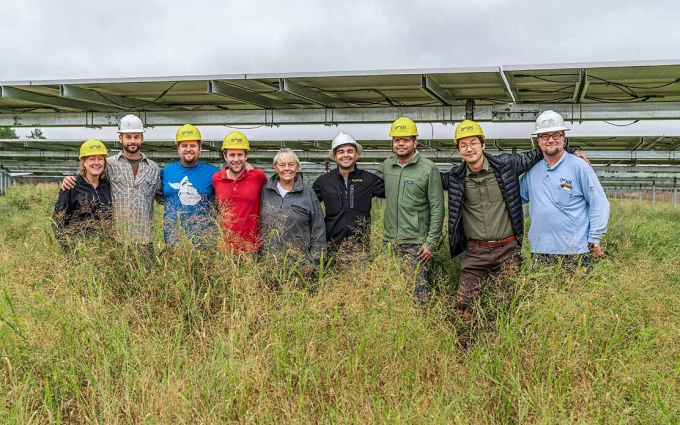November 27, 2025 | 21:09 GMT +7
November 27, 2025 | 21:09 GMT +7
Hotline: 0913.378.918
November 27, 2025 | 21:09 GMT +7
Hotline: 0913.378.918

InSPIRE researchers and industry partners collaborate on a research site in Minnesota. James McCall is third from the left. Photo: Dennis Schroeder
The cows, under the direction of Bradley Heins, Ph.D., University of Minnesota, use the panels for shade and shelter.
Double cropping solar power and organic dairy production works successfully here, but the concept – called agrivoltaics – is still very new.
Agrivoltaics is a new umbrella term defined as any farming practices on the land supporting solar power.
Around the world, innovators are looking for ways that solar panels and agriculture can benefit from the other. Flowers, pollinator plants, alfalfa, grass, vegetables and greens, and fruits and berries are some of the potential crops that people are planting in conjunction with solar panels.
Beehives, sheep, or miniature cattle enterprises could do well with the right infrastructure, too.
The challenges are matching up the theoretical with the practical – how do you get a ready source of water to livestock? What do you do with the livestock when there is lightning, and it’s not safe to be under the solar panels?
Studying both the theoretical and the practical applications of agrivoltaics is James McCall, a researcher in mechanical engineering with the National Renewable Energy Laboratory (NREL). The NREL is funded by the U.S. Department of Energy.
Matchmaking farming with solar development has gained interest for several reasons, McCall said, speaking at the 2022 Midwest Energy Conference, held at WCROC in Morris.
“To achieve the current administration’s decarbonization goals, we are going to need 10.3 million acres of land (by 2050) to achieve a high decarbonization and electrification scenario,” he said.
“We see a lot of push back from local communities who don’t really want these projects on their land or in their community,” he continued. “A solution that has popped up is agrivoltaics.”
He noted an article in The New York Times about resistance in rural areas to solar panels. (He set up a big solar farm. His neighbors hated it, published March 18, 2020)
For communities that have been concerned about solar panels ruining the rural view. McCall thinks there are ways agrivoltaics can make the view more interesting with the addition of livestock.
Coupling a solar power revenue stream with a farming revenue stream also has the potential to increase the ROI for land, equipment, and manpower. Although the initial project will cost more, it’s possible that the developer will still see a return to their investment quicker with two enterprises than only with a solar array.
Another exciting potential is growing native vegetation, flowers, and forbs under the solar garden. The vegetation could attract pollinators to increase crop pollination outside the solar garden.
Should agrivoltaics gain traction and practicality, renewable energy leaders think it could help rural communities buy into the idea of solar gardens sitting on the edges of their towns.
“There are a lot of different configurations being tested,” McCall said. Researchers are studying the effect of raising up panels so animals can walk easily underneath. There are also studies on the effect of using track panels that allow various amounts of sunlight to get through to the crops.
Of course, raising the panel racks costs more, and there are also OSHA regulations around installing solar panels at heights above 6 feet.
Another way – Low impact solar development
For farmers who are interested, McCall suggests visiting the InSPIRE webpage. InSPIRE stands for Innovative Solar Practices Integrated with Rural Economies and Ecosystems.
InSPIRE has published a primer on low impact solar development strategies. Unlike conventional solar arrays, low-impact solar developments nurture native species, produce food, retain water, and improve soil health. Instead of stripping topsoil, a low-impact site leaves topsoil in place for the growth of native vegetation. Instead of spraying the site with herbicides and mowing down weeds, a low impact site could involve livestock grazing.
“We are looking at a couple of things,” McCall said. “How do we create habitat? Can we actually harvest the water that runs off the panel and divert it to where it needs to go? How do we reduce thermal radiation stress on crops underneath solar panels?”
The solar industry is very competitive, he added. Developers have found ways to lower costs to make solar production feasible and competitive, but that is presenting issues for adoption of different configurations such as agrivoltaics.
It’s possible that agrivoltaics could help develop a more pastoral environment for communities, and additional revenue streams for developers and farmers.
pv-magazine.com

(VAN) A new study reveals how the simultaneous effects of ocean acidification, salinity and loss of oxygen are making the world more fragile.

(VAN) Hopes are growing that the creation of the first 3D turkey gut model could be a turning point in the battle against the virulent blackhead disease.

(VAN) Tyson, America’s biggest meat supplier, plans to shutter one of its largest beef processing plants as the industry continues to struggle with low cattle supplies and political pressure from Washington.

(VAN) New FAO study shows how digital solutions are empowering farmers and fishers to prevent losses and build resilient agrifood systems.

(VAN) Brazil's COP30 presidency pushed through a compromise climate deal on Saturday that would boost finance for poor nations coping with global warming but that omitted any mention of the fossil fuels driving it.

(VAN) Poultry farmers in the UK have been warned that they could face one of the worst winters yet for bird flu.

(VAN) Prices of main-crop paddy have risen sharply, with jasmine rice hitting 16,100 baht per tonne — the highest level in years.